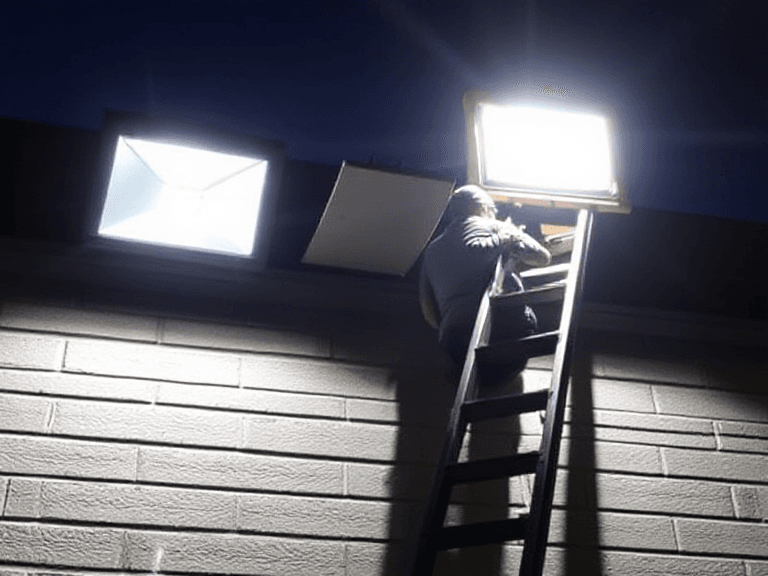Outdoor lighting plays a vital role in enhancing your property’s safety, functionality, and aesthetics. Among the various options available, flood lights are an excellent choice for illuminating large outdoor spaces. Whether you’re looking to brighten up your backyard, enhance security, or highlight architectural features, installing flood lights is a worthwhile investment. At ZZ the HandyMan, we’ve put together this comprehensive guide to help you understand everything you need to know about flood light installation.
Why Choose Flood Lights?
Flood lights are powerful lighting fixtures that cast a broad beam of light over wide areas. Here are some reasons why they’re a popular choice:
- Enhanced Security: Bright outdoor lighting deters intruders and improves visibility, making it harder for potential trespassers to approach unnoticed.
- Increased Safety: Flood lights reduce the risk of accidents by illuminating walkways, driveways, and other potentially hazardous areas.
- Aesthetic Appeal: Properly positioned flood lights can highlight your home’s architecture, landscaping, and outdoor features, creating a dramatic effect.
- Functionality: Whether hosting outdoor events or working late in your yard, flood lights provide ample illumination for various activities.
Planning Your Flood Light Installation
Before installing flood lights, careful planning is essential. Consider the following factors:
1. Purpose of Lighting
Determine why you need flood lights. Is it for security, aesthetics, or both? Your purpose will influence the type of flood light and its placement.
2. Choosing the Right Type of Flood Light
Flood lights come in various types, each suited for different needs:
- LED Flood Lights: Energy-efficient, long-lasting, and bright.
- Halogen Flood Lights: Provide a warm light but consume more energy.
- Solar-Powered Flood Lights: Eco-friendly and cost-effective, though they depend on sunlight for charging.
- Motion-Sensor Flood Lights: Activate only when motion is detected, ideal for security.
3. Identifying Key Areas
Identify areas that require illumination, such as:
- Entry points
- Driveways
- Patios and decks
- Backyard and garden spaces
- Dark corners or blind spots
4. Considering Light Placement
Strategic placement ensures optimal coverage. Position lights at an angle to avoid glare and ensure even illumination. Avoid pointing lights directly at neighbors’ windows to prevent disturbance.
Tools and Materials Needed
To install flood lights, you’ll need:
- Flood light fixture(s)
- Drill and drill bits
- Screwdriver
- Wire connectors
- Electrical tape
- Mounting brackets
- Ladder
- Voltage tester
- Weatherproof junction box (if required)
Step-by-Step Guide to Flood Light Installation
1. Turn Off the Power
Safety first! Switch off the power supply to the area where you’ll be working. Use a voltage tester to ensure no electricity is flowing.
2. Prepare the Installation Area
Choose the location and ensure it’s free from obstructions. Clean the surface where the flood light will be mounted.
3. Mount the Flood Light
- Attach the mounting bracket to the chosen surface using screws and a drill.
- Secure the flood light fixture to the bracket.
4. Connect the Wiring
- Open the fixture’s wiring compartment.
- Match the wires: black (hot), white (neutral), and green (ground).
- Use wire connectors and wrap the connections with electrical tape.
- If installing a motion sensor light, follow the manufacturer’s instructions for connecting additional wires.
5. Seal and Secure
Ensure all connections are secure and weatherproof. Use a weatherproof junction box if the installation is outdoors.
6. Adjust the Angle
Position the light at the desired angle to achieve optimal coverage. Tighten screws to keep the light fixed in place.
7. Test the Light
Restore the power and test the flood light to ensure it’s functioning correctly. Adjust the angle or sensitivity settings as needed.
Maintenance Tips for Flood Lights
To keep your flood lights in excellent condition:
- Clean Regularly: Remove dirt and debris from the fixture and lens.
- Check for Damage: Inspect wires and seals for wear or damage.
- Replace Bulbs Promptly: Swap out burned-out bulbs to maintain consistent illumination.
- Test Motion Sensors: Periodically test motion sensors to ensure proper functionality.
Professional Installation Services
While flood light installation can be a DIY project, some situations call for professional expertise. At ZZ the HandyMan, we offer reliable and efficient flood light installation services. Our team ensures your lights are installed safely and positioned for maximum impact.
Why Choose ZZ the HandyMan?
- Expertise: Our skilled technicians have years of experience in lighting installation.
- Quality Assurance: We use high-quality materials and adhere to safety standards.
- Customized Solutions: We tailor our services to meet your unique needs and preferences.
- Affordable Pricing: Get top-notch service without breaking the bank.
Final Thoughts
Flood lights are a versatile and effective way to enhance your outdoor spaces. Whether you’re installing them for security, functionality, or aesthetics, a well-planned installation ensures you get the best results. If you need professional assistance, ZZ the HandyMan is here to help. Contact us today to discuss your flood light installation needs and let us brighten up your outdoors!


